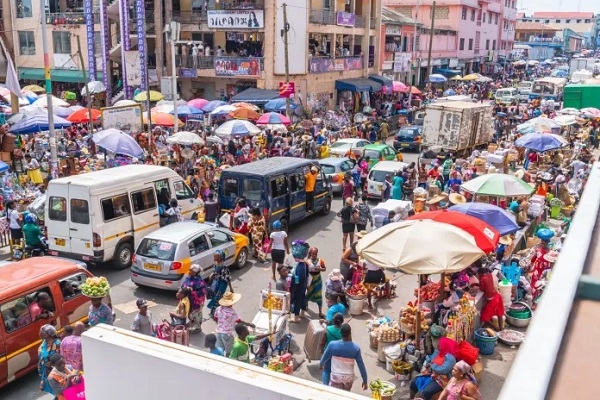Poaching, Bush Burning: Mole National Park's 'conservatory' scars - MyJoyOnline
The Mole National Park is home to a vast number of wildlife species including the Kob, also known as the African Antelope. PICTURE BY: NII ADJEI MENSAHFIO (@knii_fiofio)
Bush burning as a means of hunting was historically common in many African societies. However, while modernisation and technological innovation have significantly reduced the practice, it is still carried out in some areas, including conservation centres.
One such area is Ghana’s Mole National Park (MNP), where some people burn parts of the forests to carry out illegal hunting expeditions, otherwise known as poaching.
While smaller games such as deer, grasscutter and bushbuck are the most targeted species by local poachers, there are also suspicions of poaching attempts made on bigger games such as elephants.
The Mole National Park
One of Ghana’s seven national parks, the MNP was declared by President Kwame Nkrumah as a game reserve in 1958 and gazetted in 1971. It is the country’s premier and largest wildlife conservation centre, covering an area of about 5,477 square kilometres.
Located in the Larabanga township of the Savannah Region – about 24km from Damongo, the regional capital, and about 700km from Accra, the nation’s capital – the MNP is home to about 94 mammal species, 300 bird species, 33 reptile species and nine amphibian species. Some of the animals found in the park include the African elephant, the leopard, the buffalo, the lion, the roan antelope, the bushbuck, the kob, the hartebeest and the giant pangolin.
Many of these species are captured in the International Union for Conservation of Nature (IUCN) 2009 Red list as either vulnerable, endangered or threatened species. However, some of these species, which attract a significant number of tourists, are also the target of poaching for various reasons such as commercial and subsistence.
The MNP currently receives about 17,000 tourists per annum, with the number estimated to increase at an average of 10% per annum, according to a 2010 study. This highlights its role as a significant contributor to Ghana’s tourism fortunes, economy and overall GDP. Despite all these, poaching still takes place on the facility.
Like many national parks across Africa, the MNP suffers from poaching. According to a 2007 study, the main sources of bushmeat supply to the Techiman market in Ghana’s Bono East Region were Damongo, Daboya, Kabampe and Tuna, which are communities in close proximity to the MNP.
According to Mr. Benjamin Kwesi Agbenor , the Public Relations Officer (PRO) of the MNP, some poachers resort to burning “small” areas of the forests to hunt for grasscutters.
“Some poachers who hunt for grasscutters would like to burn small parts of the natural forest just to catch some game,” he said in March.“The smoke from these fires force the animals out of their natural homes thereby exposing them to the hunters to catch them for game.”

During a visit to the park, the debris of burnt trees were spotted in parts of the forests, suggesting the activities of these poachers may be more severe than reported.
“In that case [when they burn parts of the forests for game], they destroy the natural vegetation and this … influences climate change,” Mr Agbenor lamented.

Wildlife biologists and conservationists across the globe consider poaching to have a detrimental effect as it leads to a decline in wildlife population and the functionality of ecosystems is disturbed.
Agbenorwho also doubles as the Assistant Law Enforcement Officer of the MNP, said poaching at the park “is done on a subsistence level” and that “some of the commonest weapons used for these expeditions by the perpetrators include rifles, shot guns, gin traps etc.”
The smoke from the bush-burning by the poachers also pollutes the environment and releases greenhouse gases.
According to the World Health Organisation in a 2020 report, 28,000 premature deaths are recorded in Ghana annually as a result of air pollution, with the annual average concentration of particulate matter (PM2.5) pollution in the country being 11 times higher than WHO recommended concentration levels.
With air pollution being the second highest health risk factor for death and disability, after malnutrition, young children and adults over 50 are most at risk of disease and premature death.
Chief among the causes of poor air quality in Ghana is open burning, as well as cooking using wood and charcoal, slash-and-burn methods of farming, among others.
The Case of Elephants
The elephant population at the Mole National Park declined by over 30 per cent (from 589 to 401) between 1993 and 2006, according to a study.
In many parts of Africa, elephants are poached for their ivory. During a safari tour of the MNP, some elephants were discovered with broken tusks, while others had at least a whole tusk removed or out of place.

However, park officials said elephant poaching is rare there and that the elephants' damaged tusks were due to natural occurrences.
“Elephants could lose their tusks through fighting or in their attempts to uproot trees,” Mr Agbenor said.
“Elephant killing over here is a no at Mole National Park. We can be there for years and not hear any case of elephants being killed.”
However, the police in the area confirmed at least one report of an alleged poaching attempt on the elephants, although they admitted such incidents rarely happen.
“One particular man was brought here by the park security officials and identified as having been involved in a poaching incident prior.
“The report they [park security officials] made about him was that he had, in a previous attempt, shot at an elephant and fled, escaping arrest. But upon his second attempt, he was arrested and brought to the police station” said Assistant Superintendent of Police (ASP) Charles Aniagyei, the Damongo Municipal Police Commander.

On the frequency of poaching and arrests made, ASP Charles Aniagyei, disclosed that on an average, “between four to six suspected poachers” are sometimes brought to the station in a day in peak season which usually falls within the dry season.
To address the menace of poaching, the management of the park, led by Mr. Abass Mohammed, has undertaken several initiatives including sensitisation, law enforcement, and what they termed as “collaborative resource management.”
Under sensitisation, the management, Mr. Agbenor stated, has instituted a department that serves as an intermediary between the park and the surrounding communities. He emphasised that the relationship between the communities and the park has been “good.”
“These people [from the Department] go in to educate the communities on various issues relating to the park, especially in the area of wildlife conservation,” he intimated. “We do radio sensitisation too, where we hold programs on local radio channels to sensitise the communities on wildlife conservation. In all these, we tell them the benefits of these resources to them [the communities] and to the nation as a whole.”
Under law enforcement, Mr Agbenor disclosed that a 24/7 patrol system by park rangers is actively employed to ensure security and that nobody enters the park illegally.
“We have staff stationed at various ranges and camps of the park where they operate in to cover the entire area,” he said. “So, when you combine all these, there’s coverage of the whole park to deter poachers.”
Under collaborative resource management, the management, occasionally, invites students from various schools in the surrounding communities to experience life in the park; and also in turn, sometimes visit them; all of which are targeted at educating them on wildlife conservation.
“We also engage with traditional authorities and other stakeholders such as the Police Service, the district assemblies and others.We ensure that we spread education across all the communities surrounding the park. So, for education or sensitisation on conservation of natural resources, it goes around all the time,” he said.
The steps, he said, were yielding the needed results as appreciation for their work and the facility has increased considerably, with some communities even undertaking conservatory initiatives with support from some NGOs.
He, however, acknowledged the need for the park to be resourced, especially with technology, to enable the park’s management to carry out its duties more efficiently and effectively.
“Poaching is a headache to any conservation area around the world. Now we’re in a technology world. We will have to adopt modern technology for monitoring, surveillance and all other aspects to manage the Park. Because as conservationists, we wish to see our animals healthy and moving around freely, because we feel they’re part of us and form part of the ecosystem.”
According to ASP Charles Aniagyei, poachers brought to them by the park authorities are processed to court where they receive sanctions ranging from fines to jail terms, or in some cases, both.
The fines, he added, range from ₵3,000 ($244) to ₵6,000 ($489); while the jail term could be between two to five years.
He also revealed that most of the poachers arrested were usually farmers, followed closely by unemployed individuals, who come from both far and near during the dry season for hunting expeditions.
Despite these, the menace of poaching still persists. Some arrested poachers reportedly get bailed out by influential community members.

Officials said inadequate sanctions on arrested poachers affect the morale of staff, especially the park rangers who arrest the poachers.
In general, while the incidence of poaching atthe Mole National Park have reduced, there is a need for more deliberate and strategic interventions.
The government, as well as all other relevant authorities, should provide necessary resources to the park’s management. The staff, especially the rangers, should also be constantly motivated to boost their level of confidence in their work for both Mother Nature and Mother Ghana.
******
DISCLAIMER: The Views, Comments, Opinions, Contributions and Statements made by Readers and Contributors on this platform do not necessarily represent the views or policy of Multimedia Group Limited.
DISCLAIMER: The Views, Comments, Opinions, Contributions and Statements made by Readers and Contributors on this platform do not necessarily represent the views or policy of Multimedia Group Limited.

:max_bytes(150000):strip_icc():focal(742x328:744x330)/Ashley-Tisdale-Bush-Beans-Ashley-Tisdale-MTV-2009-Latin-America-Awards-052025-tout-300a6c960a6b47dca6ef955473bc883f.jpg)

:max_bytes(150000):strip_icc():focal(736x312:738x314)/ashley-tisdale-3-Bushs-Bluey-Baked-Beans-launch-2025-051525-fa2f8c0b10fa4d13aff07c924f5fbb11.jpg)







